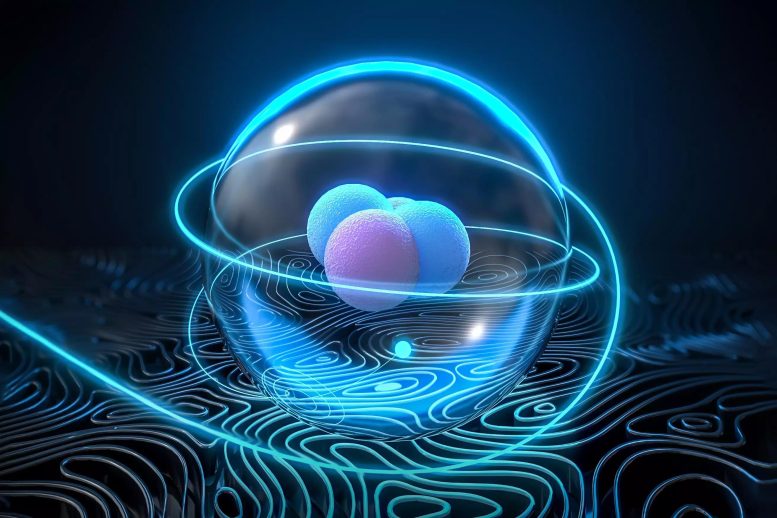
Antiprotonic helium atom suspended in liquid helium in the superfluid state. The antiproton is protected by the electron shell of the helium atom and so avoids immediate annihilation. Credit: Christoph Hohmann (LMU München / MCQST)
A team of scientists at CERN led by MPQ physicist Masaki Hori discovered that a hybrid antimatter-matter atom behaves in an unexpected way when immersed in superfluid helium. The result may open a new way for antimatter to be used to investigate the properties of condensed matter, or to search for antimatter in cosmic rays.
“Experiments on antimatter are particularly exciting with regards to the fundamental laws of physics.” — Masaki Hori
When peering into the shadowy world of antimatter, researchers have to rely on elaborate technical tricks to keep their samples of antimatter from coming into contact with the normal matter that surrounds us. This isolation is critically important because antimatter and matter immediately destroy each other on contact. An international team of scientists led by the Max Planck Institute of Quantum Optics (MPQ) in Garching has nevertheless combined matter and antimatter into curious hybrid atoms of helium that remain stable for short periods of time. Now the researchers from Italy, Hungary, and Germany have submerged the bizarre atoms into liquid helium and cooled it down to temperatures close to absolute zero — where the helium changes into a so-called superfluid state.
The results of the experiments carried out at the European Organization for Nuclear Research (CERN) in Geneva, Switzerland surprised the scientists because of the precise and sensitive way that the antimatter-matter hybrid atoms reacted to laser light despite the dense liquid that surrounded the atoms.
“Experiments on antimatter are particularly exciting with regards to the fundamental laws of physics,” says Masaki Hori, the team leader. For example, the Standard Model of particle physics — the basis of scientists’ current understanding of the structure of the universe and the forces acting within it — requires that particles and their antiparticles differ in the sign of their electric charge. An antiproton — the counterpart of the positively charged proton, a building block of atomic nuclei — carries a negative charge. According to the Standard Model the other properties are identical. “In our past experiments, we have found no evidence that the masses of protons and antiprotons differ in the slightest,” notes Hori. “If any such difference could be detected, however small, it would shake the foundations of our current view of the world.”
But perhaps the available experimental methods are just not sensitive enough to detect any subtle differences that might exist? “We can‘t rule that out before actually measuring,” says Hori. That’s why scientists around the world are fine-tuning various techniques to scrutinize the characteristics of antiparticles with ever greater precision. “To do this, atoms of antimatter have been magnetically levitated in vacuum chambers for spectroscopic measurements. Other experiments have confined antiprotons in ion traps made of electric and magnetic fields,” Hori explains. “Our team has previously used this hybrid helium atom to precisely compare the masses of antiprotons and electrons.”
With his team’s latest findings, however, the Garching physicist has paved the way for a different application of antimatter by optical spectroscopy of antiprotonic helium atoms in a superfluid environment.
Electron out, antiproton in
To create the exotic helium atoms containing antiprotons, the researchers used the Antiproton Decelerator at CERN — a globally unique facility that slows down the antimatter particles created in collisions of energetic protons. The slow velocity of the antiprotons makes them ideal for experiments such as those conducted by Hori’s team. The researchers mixed the slow antiprotons with liquid helium cooled to a temperature of a few degrees above absolute zero, or minus 273 degrees Celsius, trapping a small part of the antiprotons in atoms of helium. The antiproton replaced one of the two electrons that normally surround a helium atomic nucleus — forming a structure that remained stable long enough to be studied spectroscopically.
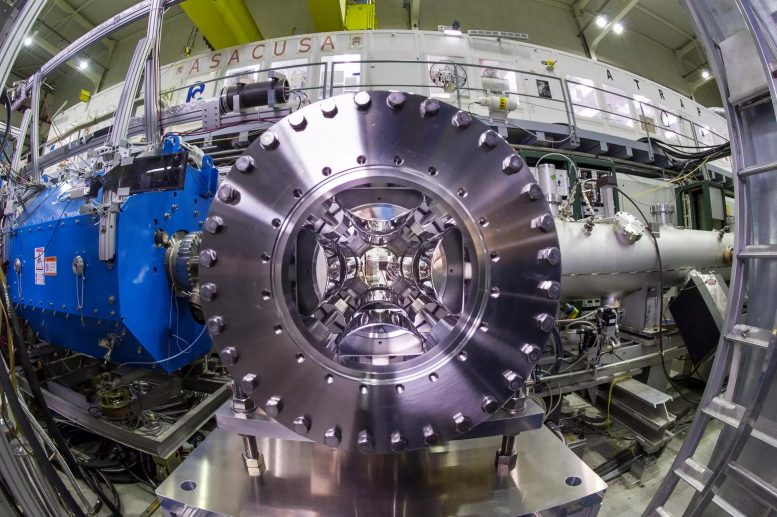
Photograph of the quadrupole triplet lens used to focus the antiproton beam into a helium target. Credit: CERN
“Until now, it was thought that antimatter atoms embedded in liquids could not be investigated by high-resolution spectroscopy using laser beams,” Hori reports. This is because the intense interactions between the densely packed atoms or molecules of the liquid lead to a strong broadening of the spectral lines. These lines are images of resonances in which the energy absorbed from the laser beam excites the atoms. They are thus a kind of fingerprint that identifies each atom. The exact position of the resonance line on the frequency scale as well as the shape reveal the properties of the atom under investigation — and the forces acting on the antiparticle. But the broadening of the lines obscures this information because it is virtually smeared. Hori and his team have now succeeded for the first time in preventing the “smearing” of the spectral lines in a liquid.
Surprisingly slim line at 2.2 Kelvin
In a series of experiments, the scientists took a spectroscopic look at the antiprotonic helium atoms at different temperatures. To do this, they irradiated the liquid helium with light from a titanium-sapphire laser, which excited two characteristic resonances of the antiprotonic atoms at two different frequencies.
The surprising discovery: “If the temperature dropped below the critical temperature of 2.2 Kelvin – 2.2 degrees Celsius above absolute zero — at which helium enters a superfluid state, the shape of the spectral lines suddenly changed,” reports Anna Sótér, who was the principal PhD student of the MPQ team in this project and recently promoted as assistant professor of ETH Zürich. “The lines that were very broad at higher temperatures became narrow.”
The superfluid phase is a special liquid state that is characterized, among other things, by the absence of internal friction. The quantum physical phenomenon is typical of helium at extremely low temperatures. “How the striking change in the spectral lines of the antiproton comes about in such an environment and what happens physically in the process is something we don’t know yet,” says Hori. “We were surprised by it ourselves.”
But the possibilities offered by the effect are far-reaching. This is because the narrowing of the resonance lines is so drastic that when excited with light, the so-called hyperfine structure can be resolved, the scientists report in a publication in Nature. The hyperfine structure is a consequence of the mutual influence of the electron and the antiproton in the atom. This indicates that researchers could create in superfluid helium other hybrid helium atoms with different antimatter and exotic particles to study in detail their response to laser light and measure their masses. An example of this is pionic helium atoms that were recently studied by laser spectroscopy at the 590 megaelectron volt cyclotron facility of Paul Scherrer Institute in Villingen, Switzerland.
Searching for particles in cosmic radiation
The sharp spectral lines could also be helpful in detecting antiprotons and antideuterons in cosmic radiation. Researchers have been on the trail of these for years, for example with experiments on board the International Space Station (ISS). Soon, scientists will also launch a test balloon over Antarctica — with an instrument on board that can detect antiprotons and antideuterons that may exist at very high altitudes in the atmosphere.
Masaki Hori speculates: “Detectors with superfluid helium may support future experiments and may be suitable for capturing and analyzing antiparticles from space. Numerous technical challenges must be overcome, however, before such methods become complementary to existing ones.”
This would possibly help solve another great mystery: the question of the nature of dark matter — an ominous and hitherto unknown form of matter that is invisible but apparently accounts for a large part of the mass in the universe. In some theories, it is believed that when dark matter interacts in the halo of our Galaxy, antiprotons and antideuterons may be produced that could then be transported to the Earth. Antimatter, of all things, could shed light on this darkness.
For more on this research, see Unexpected Behavior of Hybrid Matter–Antimatter Atoms in Superfluid Helium Surprises Physicists.
Reference: “High-resolution laser resonances of antiprotonic helium in superfluid 4He” by Anna Sótér, Hossein Aghai-Khozani, Dániel Barna, Andreas Dax, Luca Venturelli and Masaki Hori, 16 March 2022, Nature.
DOI: 10.1038/s41586-022-04440-7

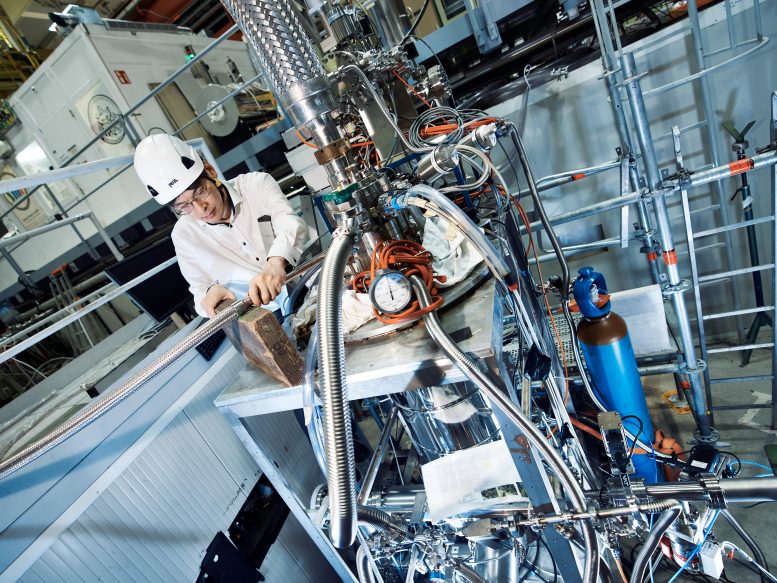

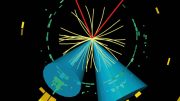
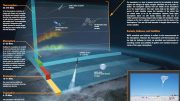

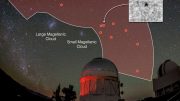

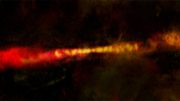

…
Ik probeer mij voor te stellen ruimtelijk en functionerend uitziet.Volgeens de wetenschappers dijt het heelal uit met bijna de lichtsnelheid.Aan de rand van het heelal er een proces plaats waarbij de massa over gaat in energie(donkere negatieve energie ?)en de radio achtergrond ruis veroorzaakt ? Door het ontstaan van de enorme zwaartekracht van de massa ontstaan door het bereiken van de lichtsnelheid gaat de radiostraling via de aantrekkingskracht van het enorme zwarte gat(in het middelpunt van het heelal).Hoogstwaarschijnlijk vinden er overal in het heelal processen plaats waardoor nieuwe materie ontstaat(sterrenstelsels ?).Zo is er een in zichzelf terugkerend oneindig proces ontstaan.Met de huidige techniek is het nog niet mogelijk om tot aan de horizon van het heelal waarnemingen te doen omdat door de constante van de lichtsnelheid en de enorme zwaartekracht het licht wordt afgebogen tot de uiterste cirkel van het heelal.Als de materie overgaat in antimaterie en terugkeert naar het midden van het heelal heb je een eeuwigdurend veranderend proces.Ik heb het gevoel dat het onderzoek van het allergrootste en het allerkleinste de relativiteitstheorie en de quantumtheorie in een theorie samenvat.Ik noem mijn theorie de yin yang theorie.(IK heb er ruimtelijke afbeeldingen van gemaakt maar kan die niet meesturen)